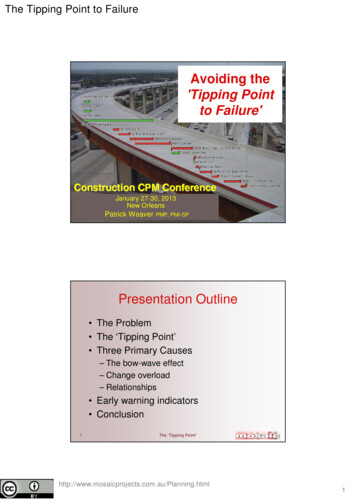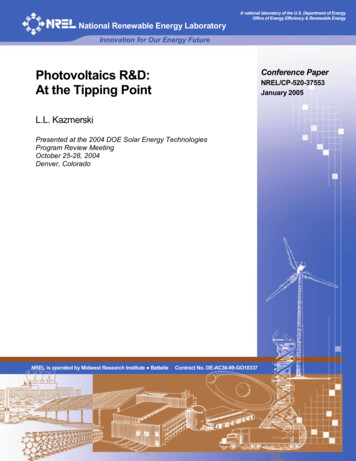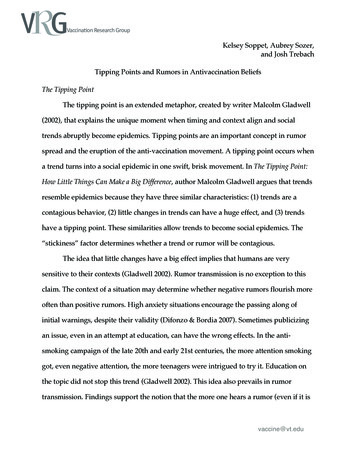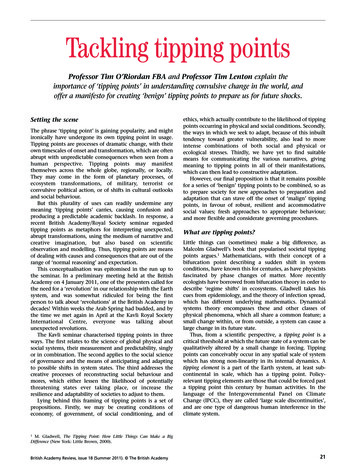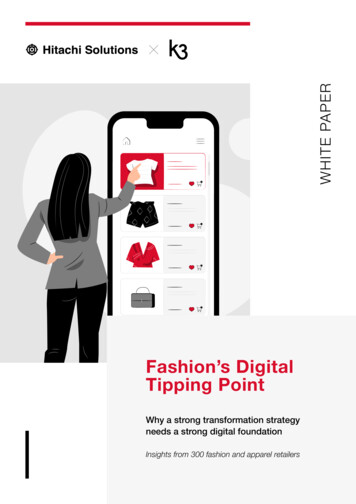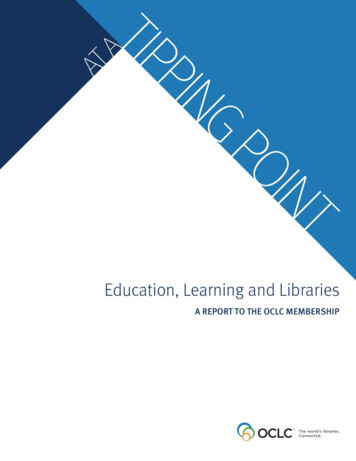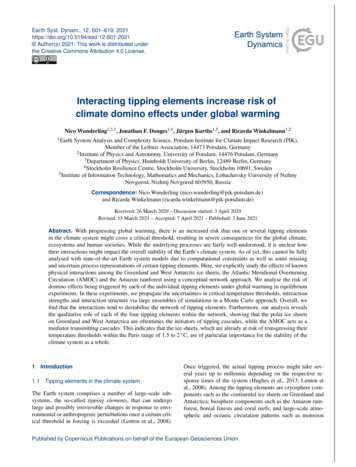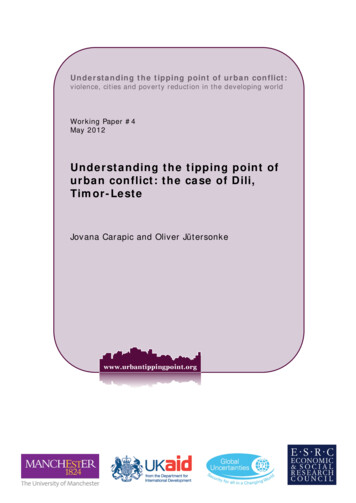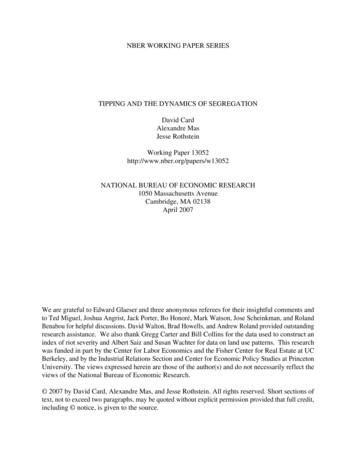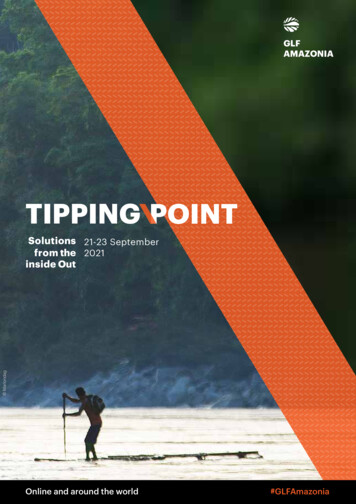
Transcription
GLFAMAZONIATIPPING POINT MarlondagSolutions 21-23 Septemberfrom the 2021inside OutOnline and around the world#GLFAmazonia
2TIPPING POINTConcept NoteOn 21-23 September 2021, the Global LandscapesForum (GLF) will host the largest global conference onthe Amazon Biome, to bring to the fore local solutions topreserve and restore the biological and cultural diversityof the world’s largest humid tropical forest. This eventwill be held as 40 percent of the Amazon nears thetipping point of irreversibly losing its function as watergenerating rainforest – a catastrophe for human wellbeing and planetary health that can still be prevented ifthe world acts now.The tragedy of the COVID-19 pandemic has sharpenedthe global community’s attention to the social justiceand ecological challenges – including climate change– that our societies face. As youth across the globe,as well as Indigenous Peoples and Local Communities(IPLC), continue to demand today’s decision-makersto take meaningful action on climate change andsustainable finance, leaders across all sectors ofsociety – both public and private – are beginning torethink current economic models. As such, a uniqueopportunity exists to catalyze change for the Amazon. Marco Simola/CIFORThe two-day digital conference will take place duringClimate Week 2021 (September 20-26), and lead intothe 30th anniversary of the 1992 Rio Earth Summit.The event – and the activities and coverage in themonths leading up to and following it – will serve tospotlight, amplify and support existing and ongoinglocally-led initiatives and leading scientific researchand campaigns. It will also provide a pathway foralliances, collaborations, outcomes, agreements,policy asks and recommendations to inform theUnited Nations’ Framework Convention on ClimateChange (UNFCCC) 26th Conference of the Parties(COP26) in November 2021.The conference invites practitioners; IndigenousPeoples and Local Communities (IPLCs); Afrodescendant Peoples (ADPs); quilombolas andmaroons; peasant and women’s, farmers’,conservation, development and other civil societyorganizations; community leaders; researchers;policymakers; financial investors and private sectorrepresentatives; youth groups; activists; and otherlocal and global actors to attend and engage.The event will be packed with plenaries, interactivesessions, launchpads, networking opportunities andlearning journeys designed to engage those livingin, fighting for and/or trialing innovative business,farming and governance models within the AmazonBiome. A dedicated media training session forjournalists from across the Amazon and a socialmedia bootcamp will develop capacity and amplifyreach and impact.The Amazon Biome is defined as the areacovered predominantly by dense moist tropicalforest, with relatively small inclusions of severalother types of vegetation such as savannas,floodplain forests, grasslands, swamps,bamboos and palm forests. The biomeencompasses 6.7 million square kilometers(2.6 million square miles) and is shared byeight countries (Brazil, Bolivia, Peru, Ecuador,Colombia, Venezuela, Guyana and Suriname),as well as the overseas territory of FrenchGuiana. The complete watersheds expandbeyond the biome and sometimes includeadjacent biomes (dry forest, cerrado and puna).
Online and around the worldWhy the Amazon?The Amazon Biome is one of the most culturally andbiologically diverse regions on Earth.It is a large and dynamic landscape cutting across manycountry, district, tribal and ethnic borders with differenteconomic models, political systems and visions forthe future where multiple actors, livelihoods, and ideascoexist, compete and cooperate.The biome is home to more than 410 ethnic groups– including both Afro-descendent and IndigenousPeoples – 60% of which still remain largely isolated.Together with Andean and lower-altitude mountainforests, the tropical rainforest provides vital ecosystemservices such as food, water and medicines, and holdsspiritual significance for millions of people.The biome is one of the most important globalstorehouses of biodiversity, harboring over 10% ofEarth’s known species – including many that areendemic and/or endangered.The 6,600-kilometer (4101-mile) Amazon River is oneof the two largest rivers on Earth. It contributes to over15% of the world’s total river discharge into the oceans,providing water and nutrients to an area twice the sizeof India.The Amazon’s canopy cover helps regulate regionalclimate through forest-dependent hydrological cycles,and generates almost half of its own rainfall. Thebiome contains 90-140 billion metric tons of storedcarbon, the release of even a portion of which wouldaccelerate global warming significantly.However, uncontrolled expansion of cattle ranches,agriculture and mining combined with unsustainableextraction of timber and wildlife, is threatening theAmazon’s unique biology and cultures. Over thepast 50 years, an United-Kingdom-sized area of theAmazon has been deforested and a football-pitchsized area is currently being cleared every singleminute, according to satellite data.Human- and land-rights violations towardsenvironmental defenders are at an all-time high, with3IPLCs at a disproportional risk of reprisals andthe greater Amazon region particularly affected.An inclusive, equitable, resilient, sustainable andprofitable nature-based path for the Amazoncan only emerge from the inside out, led by theAmazonian people and their organizations.COVID-19The global COVID-19 pandemic has demonstratedthat human society is entirely capable of mobilizingresources, adapting lifestyles and uniting behinda single goal – all of which we will need to do inorder to save the Amazon Biome and mitigateglobal climate change. However, it also exposedthe vulnerability of our economies to shocks,and has laid bare deep social inequalities thatthreaten to derail progress towards the SustainableDevelopment Goals. A large number of IPLCs,many of which play traditional environmentalstewardship roles, have been hit particularly hardby the disease. COVID-19, like Ebola, has remindedus that deforestation and forest fragmentationbrings people and wildlife into close contact,leading to higher risks of zoonotic diseases. TheGLF hopes that the conversations convenedaround this event will help ensure post-pandemicrecovery efforts are both equitable and sustainableand help inspire the changes needed to maintainthe vital functions of the Amazon Biome, theworld’s climate and the recognition and respect ofthe stewards of nature.Building on existingknowledge – solutions fromthe inside outGLF Amazonia will bring together different kindsof knowledge, highlighting both local solutions– including those that indigenous peoples havepracticed and adapted throughout their histories –as well as more recent innovations that have beendeveloped to ensure equitable, just and sustainableuse and distribution of the Amazon’s resources.Ecological Tipping Point:Finding sustainable pathways for the Amazon is imperative, as forest conversion and degradation togetherwith climate change are fueling forest fires and driving the ecosystem dangerously close to an irreversibletipping point (which scientists have estimated to occur at around 20-25% total deforestation from currentlevels). There is no time to lose. Earth systems modeling shows that 50-60% of the eastern, southernand central Amazon rainforest would be replaced by degraded landscapes and dry forests if the systemwere to flip to a new vegetation-climate equilibrium. The solutions we seek must urgently address thesynergistic effects of climate and land-use change to avoid altering the biome forever.
4TIPPING POINTA territorial or landscape approach offers a holistic,integrated perspective at a scale that allows formeaningful and effective solutions. It is at the territorialor landscape level where different types of use can becombined and balanced. It is also the level at whichmeaningful impact and change becomes imaginable –from tackling insecure tenure, community and genderrights and addressing food insecurity and declining rurallivelihoods and health, to restoring degraded ecosystems,protecting and conserving biodiversity-rich landscapes,and promoting sustainable value chains and use ofnatural resources.ThemesMuch work and research has been done in the greaterAmazon region. Recognizing and building on this work,GLF has identified the following key topics, questionsand challenges that will be defined by partners andparticipants, through a transparent, collaborativeagenda-setting process:Convening under the theme of ‘Solutions from the insideout’, participants will focus on accelerating sustainable,nature-based action towards an equitable and resilientAmazon Biome, by adopting an integrated, transboundaryand rights-based approach that protects the tenurerights of Indigenous Peoples and Local Communities andAfro-descendent Peoples. As pioneered at the 2020 GLFBiodiversity: One World, One Health Digital Conference,the GLF will apply a multidisciplinary approach in which thepower of multiple disciplines to work together for optimalhuman, animal and environmental health can be harnessed.GLF’s last conference of 2021, GLF Glasgow: Forest, Food,Finance – A New Deal for Earth, will take place less thantwo months after GLF Amazonia, and it will provide aplatform to inform the formalUNFCCC process with the earlier event’s outcomes,questions and recommendations. Marco Simola/CIFORProposed conference objectivesand themesObjectives1. learning from and across the different bioculturalidentities in the Amazon Biome, and the developmentof a common vision for a sustainable future for thebiome and its people;2. a platform for Indigenous Peoples and LocalCommunities and Afro-descendent Peoples to voicetheir needs, ambitions and visions on assuring a safeand prosperous future for themselves and their families;3. sustainable finance and responsible investment forinclusive and resilient value chains;4. new commitments to upscale cross-sectoral land-useplanning in the Amazon Biome;5. a dialogue between indigenous knowledge andpractices, and innovative technologies derived fromWestern science;6. a spotlight on nature-based businesses that can bebrought to scale; and7. knowledge and understanding of synergies betweenexisting coalitions and movements. Marlon del Aguila Guerrero/CIFORThe conference aims to provide and/or facilitate:
Online and around the worldThe various biocultural identities ofthe Amazon Biome What are the contemporary biocultural identitiesin the Amazon, and how can these contribute tosecuring the future of the landscape? How do local actors define human-naturerelationships based on local philosophies andhow do these concepts find expression in naturalresource management and economic activities? What role do civil society and grassrootsorganizations play in preventing the biome’secological and cultural collapse? How are theseconnected and resourced? How has COVID-19impacted these organizations? How to strengthen existing alliances and help fostera new coalition to sustain and save the bioculturalidentity of the Amazon? What are the key elements required to establishimpactful, sustainable movements and raiseawareness on the challenges faced in the Amazon?How can connections with, and lessons learnedfrom, movements beyond the Amazon Biomesupport local movements?An equitable, resilient and circular bioeconomy What are the models, elements and opportunities foran equitable, resilient circular bioeconomy? How can sustainable value chains support a circularbioeconomy and which green commodities shouldbe supported to promote ecosystem conservationand restoration? What kinds of investmentsare needed? What are the drivers to catalyzesustainable finance for green commodities valuechains and restoration projects? How can local communities transition frombeneficiaries to partners in development programs? What role can and should local micro, small,medium and large enterprises play in creating anequitable, resilient and circular bioeconomy? What are the incentives and opportunities forpublic-private partnerships? What role can and should be played by supply chaindue diligence? What role can and should be played by overseasbusinesses, investors, governments, NGOs andother actors from outside the basin?Transboundary governance and cross-sectorialland-use planning Definition and governance of Amazonian regionalpublic goods What are the implications of the relationshipbetween the Andes and Amazon ecosystems?And Leticia Pact? What are common entry points for regionalgovernance aiming at conservation, sustainable use ofbiological diversity, and the fair and equitable sharingof benefits arising from the use of such biodiversity5in the Amazon region? Who can facilitate regionalcooperation and coordination? What are the capacityneeds for institutional change? Solutions for inclusion of local institutions andrights-holders Which cross-sectoral land-use planning programsand initiatives are proving successful, and why? How should we mainstream biodiversity and theprotection of Indigenous rights into different sectors?Incentives, disincentives and policy instruments What opportunities exist through environmental,social and governance (ESG) mandated investmentfunds? How can legal stakeholders be empowered andstrengthened? What is the status of Indigenous Peoples and LocalCommunities’ as well as Afro-descendent Peoples’tenure rights? What strategies could be used toscale up recognition, protection and security ofthese rights? What examples exist of enabling regulatoryframeworks that consider the diversity of bioculturalidentities? What examples exist of regulatory frameworks thatencourage behaviors that will contribute to buildinga profitable, inclusive, equitable, resilient andsustainable biome? What sets them apart, and whatcan we learn from them? What kind of changes areneeded in regulatory frameworks such as miningand oil policy, and plans that affect the biome’sbiodiversity and the rights of Indigenous Peoplesand Local Communities’ as well as Afro-descendentPeoples’? How can and do overseas governments’ advice (e.g.nutrition advice on meat consumption); regulation(e.g. bans on imported deforestation); subsidies(e.g. subsidies on batteries for electric cars and solarpanels requiring minerals found in the Amazon); andforeign assistance support and/or undermine localinitiatives and policies?The role of technology and traditionalknowledge What role can and should technology playwithin the biome – from information technologyconnecting remote areas, to logistical solutions andmonitoring? What innovative examples exist that areready for replication, scaling or investment? Whatgaps and innovation needs remain? How can technology support Indigenous Peoplesand Local Communities and Afro-descendentPeoples in monitoring their territories, as well asguaranteeing livelihood and inclusion?
6TIPPING POINTWho is this event for?The GLF Amazonia is expected to convene morethan 5,000 participants, engage tens of thousandsmore online, and reach tens of millions globally. Theconference invites practitioners; Indigenous Peoplesand Local Communities (IPLCs); Afro-descendantPeoples (ADPs); quilombolas and maroons; peasantand women’s, farmers’, conservation, developmentand other civil society organizations; communityleaders; researchers; policymakers; financial investorsand private sector representatives; youth groups;activists; and other local and global actors whoare actively engaged in creating a sustainable,resilient and inclusive nature-based economies andimplementing regulatory frameworks in the greaterAmazon region.We will bring local experience to the highest levels ofglobal policy-making to bridge gaps between actorsand sectors and help scale up promising initiativesand practices. We are also exploring opportunitiesto collaborate with local partners on translatingknowledge into inclusive online learning journeys.A growing global onlinecommunity and movementfor changeThe year of 2020 was marked by a global pandemic andvarious climate and environmental crises, GLF was oneof the few organizations able to swiftly move its functionsand communications online. In 2019, GLF predicted atrend toward digital conferencing, especially with thegrowing tension among the environmental communityto fly less. It was decided that its flagship conference,GLF Bonn, would be held entirely online in 2020.The GLF conferences have been attended by acombined total of 250,000 participants from 185countries, and the GLF’s youth program has involvedmore than 60,000 current and future leaders underthe age of 35. Also, GLF’s conferences typically reachbetween 35 and 50 million in social media, havingmore than 5,000 participants per digital conference.The digital conference format has allowed GLF’sreach, conference attendance, gender, sectoral andregional inclusivity and audience engagement togrow exponentially - while at the same time drasticallyreducing CO2 emissions and saving public funds.GLF Amazonia will facilitate even wider accessibility viamobile devices and will provide low-bandwidth contentto ensure the broadest possible participation – especiallyby those living in remote areas. The GLF will reachout to and partner with government agencies, NGOs,communications companies and technological expertsto further enable this access. Through our purpose-builtconference platform, participants across the Amazon willbe encouraged to connect and organize subgroups and– where possible and safe – face-to-face meetups (whilefollowing public health and safety regulations to preventthe spread of COVID-19). This blended format makes fora more inclusive forum, while cutting the greenhouse gasemissions incurred by conventional in-person events.The GLF has also been invited by the Government ofthe United Kingdom to play a role in the upcomingUNFCCC COP26 process in November this year, bycollaborating to organize a three-day hybrid conference,GLF Glasgow, that will spotlight how forests, sustainablefood systems and sustainable finance can accelerateaction toward achieving the Paris Agreement goals. Thiswill allow the GLF to take forward outcomes, policy asksand recommendations from GLF Amazonia to decisionmakers and influencers at the COP.In addition, financial institutions have a role to play inavoiding damaging impacts on the Amazon Biome andproactively channeling financing towardsecosystem conservation and restoration. Sustainablefinance mechanisms can offer important solutions –providing it does not only screen out ecosystem andbiodiversity-related investment risks, but also increasesthe amount of capital available to support nature-basedsolutions at scale.Youth in Landscapes InitiativeYoung people are amongst the leading defenders ofthe Amazon – sometimes at great personal risk. Incollaboration with the Youth in Landscapes Initiative(YIL); GLF’s Restoration Steward for forests in Argentinaand her affiliated organization (Proyecto Reserva NaturalMonte Alegre); GLFx chapters; and other local youthorganizations, the GLF will invite young people to take partin both GLF Amazonia and a series of pre-event dialogues,which will help to shape the event itself and incorporatethe needs and perspectives of local youth.GLFxThe GLFx initiative is designed to enable localcommunities to accelerate action on the groundthrough the Landscape Approach, while buildingconnections across the vast GLF global network. AtGLF Amazonia, local GLFx chapters will kick-start anew network of independently-organized local actorscommitted to conserving, protecting and restoringtheir Amazonian landscapes. These local chapterswill also work to strengthen existing communitiesof practice, and help pave the way to conserving,protecting and restoring the Amazon Biome from itscurrent course of biocultural collapse.
Online and around the worldWays to participateThe two-day event will be packed with plenaries,interactive sessions, structured networking, virtualtours, documentary screenings, press conferences andmore.There are many other ways to participate, includinghosting and/or attending activities such as learningtracks, inspirational talks, plenaries, interactivesessions, #GLFLive Q&A sessions, polls, launchpadsand more. For more information, please contactGLF Global Assistant Coordinator Judith Sonneck(j.sonneck@ cgiar.org).Communications, outreachand engagementLF Amazonia will leverage the communicationand digital marketing capacity of the GLF andthe Center for International Forestry Research– World Agroforestry Centre (CIFOR-ICRAF), aswell as of the 31 GLF Charter Members, engagedpartners, influencers and conference speakers’and participants’ networks, to inform an inclusive,equitable, resilient, sustainable and profitable futurefor the Amazon region and its people and theglobal climate.The building blocks for this narrative includemultimedia and social media content, as well as localperspectives and human-interest stories on the groundthat bring to life the complex biological and culturalsystems that define the Amazon’s landscapes. Contentand campaigns will be disseminated in Spanish,Portuguese and English (with other languages to bedetermined) in order to engage comprehensively withregional and international audiences, with a focuson attracting and retaining a large audience in LatinAmerica in particular.Prior to the event, a media training will take placeonline with up to 40 journalists from across theAmazon Biome. The GLF will also seek mediapartnerships with key publications, blogs, podcastsand radio stations in the target countries.The 2021 cohort of 34 young volunteers actingas GLF social media ambassadors, from 24countries across Africa, the Americas, Asia andEurope, will report the conference in real-time,using their own social media channels on Twitter,Facebook, Instagram, YouTube e LinkedIn tospark meaningful conversations on landscapeapproaches to address environmental, social andhealth challenges.GLF Amazonia’s local, global, Indigenous Peoplesand Local Communities and Afro-descendentPeoples partners, as well as its Charter Members,will contribute insights and content, and are invitedto join the communications committee. For moreinformation, please contact GLF CommunicationsCoordinator Melissa Angel (m.kayeangel@cgiar.org).Sponsorship opportunitiesOver the past eight years, the GLF has reachedclose to a billion people across the world andestablished itself as the world’s largest forum onintegrated and sustainable land use management,supported by the GLF Charter Members – 30leading development organizations that includethe World Bank, World Wildlife Fund, WorldResources Institute and Rainforest Alliance.Brands that support the GLF are associated with amovement that has so far engaged 7,400 entities,including international organizations, governments,universities, corporations and community groups.Sponsorship packages are available, as well ascustom-made and exclusive sponsorships, suchas supporting a specific community of practice, aGLFx chapter, youth activities and more. For moreinformation, please contact GLF Engagement andGrowth Coordinator Nina Haase(n.haase@cgiar.org).7
8TIPPING POINTFor all information regardingGLF sponsorship packages andpartnership engagement, pleasecontact GLF Engagement andGrowth Coordinator,Nina Haase.Mobile number: 31 617518388Email: n.haase@cgiar.orgJOIN US FOR GLF AMAZONIA lobal Landscapes ForumThe Global Landscapes Forum (GLF) is the world’s largest knowledge-led platform on integrated land use, dedicated to achieving the SustainableDevelopment Goals and Paris Climate Agreement. The Forum takes a holistic approach to create sustainable landscapes that are productive, prosperous,equitable and resilient and considers five cohesive themes of food and livelihood initiatives, landscape restoration, rights, finance and measuringprogress. It is led by the Center for International Forestry Research (CIFOR), in collaboration with its co-founders UN Environment and the World Bank andCharter Members.Charter Members: CIAT, CIFOR, CIRAD, Climate Focus, Conservation International, Crop Trust, Ecoagriculture Partners, EFI, Evergreen Agriculture, FSC, GEF, GIZ,ICIMOD, IFOAM - Organics International, ILRI, INBAR, IPMG, IUFRO, Rainforest Alliance, Rare, RRI, SAN, UN Environment, (TMG) Think Tank, Wageningen Centre forDevelopment Innovation, part of Wageningen Research, WFO, World Agroforestry, World Bank Group, WRI, WWF Germany, Youth in Landscapes Initiative.Funding capesforum.org #GLFAmazonia Marco Simola/CIFORContacts
tipping point (which scientists have estimated to occur at around 20-25% total deforestation from current levels). There is no time to lose. Earth systems modeling shows that 50-60% of the eastern, southern and central Amazon rainforest would be replaced by degraded landscapes and dry forests if the system
